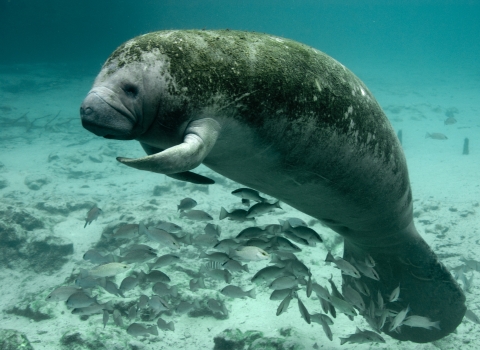Jim Halpin, a 14-year veteran with the U.S. Fish and Wildlife Service, will be the new refuge manager of the 8,542-acre National Key Deer Refuge in Big Pine Key, Florida. Currently deputy refuge manager at Aransas National Wildlife Refuge in Austwell, Texas, Halpin will start his new position in October or November.
"We're excited that Jim's coming to Key Deer," said Sam D. Hamilton, Southeast Regional Director. "He has lived or worked on 12 islands on the Atlantic and Gulf coasts of the United States. With 12 years of experience managing coastal refuges, he has a great background to meet the challenges of the Keys."
As deputy refuge manager of the 70,504-acre coastal refuge of Aransas, Halpin worked closely with the Peregrine Fund to reintroduce the endangered northern Aplomado falcon to the refuge. He is currently involved in a cooperative effort with local governments, businesses, and historical organizations to seek funding to allow public use of Matagorda Island National Wildlife Refuge and be positioned to re-light the Matagorda Island Lighthouse by the new millennium.
"I hope to continue to work closely with the community when I assume my new position at National Key Deer Refuge," said Halpin. "I'm very interested in the refuge's new Friends Group, and hope my family and I can become fully involved as good neighbors and community members in the Keys."
Halpin joined the U.S. Fish and Wildlife Service in 1985 as a biological technician at Pinckney Island National Wildlife Refuge in Hilton Head, South Carolina. Three years later, he became Assistant Refuge Manager at Harris Neck National Wildlife Refuge in Townsend, Georgia for two years. He then moved to Newburyport, Massachusetts as Assistant Refuge Manager of Parker River National Wildlife Refuge. For four years, Halpin served as the refuge manager at Great Bay National Wildlife Refuge in Portsmouth, New Hampshire. He then became Deputy Project Leader at Blackwater National Wildlife Refuge in Cambridge, Maryland before entering his current position at Aransas, where he has also served for two years.
Jim began his federal career with the National Park Service at Assateague Island National Seashore, Fort Pulaski Pulaski
The Pulaski is a special hand tool used in wildland firefighting. The tool combines an axe and an adze in one head, similar to that of the cutter mattock, with a rigid handle of wood, plastic, or fiberglass. The Pulaski is a versatile tool for constructing firebreaks, as it can be used to both dig soil and chop wood.
Learn more about Pulaski National Monument in Savannah, Georgia, and at Acadia National Park in Bar Harbor, Maine. Halpin was in the U.S. Army for three years and served a tour in Vietnam as a First Lieutenant in Special Forces.
Halpin holds a bachelor of science degree in Biology from Davis and Elkins College in Elkins, West Virginia. Halpin enjoys fishing, boating, gardening, volleyball, and travel. He has backpacked in Europe and has traveled in Asia, Australia, and numerous Pacific Islands. He is married and has a 6-year- old daughter, McKenzie. His wife, Kim, is also with the U.S. Fish and Wildlife Service, and currently works as the Outdoor Recreation Planner at Aransas, TX.
The National Key Deer Refuge, established in 1957, hosts magnificent birds -- ospreys, brown pelicans, piping plovers, peregrine falcons, red-shouldered hawks, least terns, herons, egrets, cormorants, frigate birds, bald eagles, and white-crowned pigeons. Besides the Key deer, for which the refuge is named, 21 other endangered or threatened species occur there; including American crocodiles, Key Largo woodrats, Key Largo cotton mice, Lower Keys marsh rabbits, Florida tree cacti, silver rice rats, and loggerhead, hawksbill, and leatherback turtles. The refuge is also home to the rare tropical hardwood hammock habitat.
More than 90,000 annual visitors enjoy guided tours, birding, wildlife observation, and photography at Keys refuges. Key Deer's 12-person staff also oversees three satellite refuges in the Keys -- Key West National Wildlife Refuge, Great White Heron National Wildlife Refuge, and Crocodile Lake National Wildlife Refuge.


